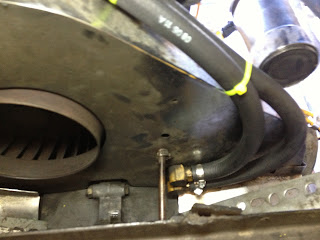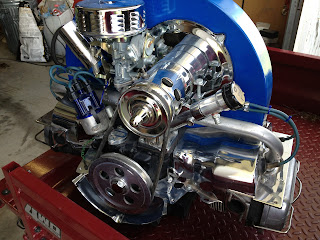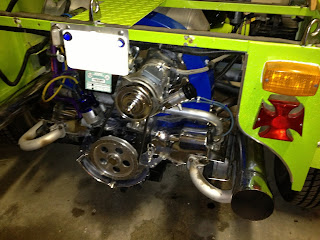Before I get on with the seat, I have some other update duties to perform.
Kermit had started stalling at most stops, especially in such conditions as a freeway exit or getting caught by a light in a long straightaway. He would always start right back up and and appear to return to normal without issue.
I suspected either of two things, idle circuit adjustment or the throttle cable arrangement, and really, I figured it would be a combination of the two.
Well, spent a good half day dinking with them both to no avail. I found that even sitting in the shop, I was able to duplicate the issue... If I held the engine at 3000 rpm or so, it would die when I closed the throttle. I also noticed that it had a little bit of a miss during that rev.
Then I finally figured it out, having until then ignored the very thing I had installed specifically to catch this kind of problem! The
inline fuel pressure gauge was showing 1 PSI. I shut the engine off and was able to squeeze the hose and get the indicator to swing full scale, so it wasn't a bad gauge. Started again and watched the gauge. When running at 3000 rpm, pressure dropped even lower, then about the time the engine would die, the pressure would come back up to 1 PSI. The entire circuit from tank to carburetor is less than three feet as the hose flies.
Long story short (too late), it was the fuel pump. Makes sense... could provide good enough volume to run, though a little lean at higher rpm, then when you come off the throttle, it dies because the idle circuit picks up from the top of fuel bowl. By the time you can restart it, the pump has caught up and filled the bowl. Rinse. Repeat.
So, dashed down to O'Reilly in Decatur (about a 30 minute round trip) and got another
fuel pump and a new filter. All hooked up, 5 PSI, can't kill it now.
That day, we went on a ride just short of 150 miles and it didn't (unexpectedly) die once.
So, fast forward a week and I have a new (new to me, anyhow) Hobart AirForce 250ci plasma cutter to play with. Wanted a plasma cutter forever and finally had both the wherewithall to drop a few bucks on one *and* a decent price for a used one on Craigslist. Actually, it's so barely used, it may as well be new.
It can cut.
I chipped the dross off, but this is how it does it.
One of my upcoming projects, and honestly one of the reasons I wanted the plasma torch now, is a replacement fuel tank for the purple trike. That will be made of 16ga mild steel.
In any case, today's project was replacing the seat on Kermit. The old seat came from the basement at American Motorcycle Trading Company in Arlington. It appears to have been a take-off from a modern Indian motorcycle. Decent enough seat, though a trike puts more weight on your tailbone than a motorcycle typically does, so said tailbone can really tell when you've been on a long ride.
After looking at a *LOT* of seats online, mostly boat and tractor seats, we decided to try a particular
tractor seat from Northern Tool, which also happened to be on sale for $70.
I knew that it would involve building a bracket of some sort to mount pretty much any seat, so after some test fitting and test sitting (by Gabby; I don't fit on Kermit), I had an idea that 2" square tubing would work pretty well.
There was no easily accesible square tubing to be had on Saturday, but I did get some 2" 90 degree angle from Lowes. Using my schmancy new plasma torch, I learned how not to cut a straight line, then refined the technique until I *could* cut a straight line and zeroed in on a plan to give 2" square tubing in the place I wanted it most, at the ends, by welding a short piece of angle to the span thusly:
The overal bracket is basically U-shaped, with the square "tube" ends holding the back of the seat suspended on a body crossmember and the front sitting on an existing pedestal that I would otherwise just as soon cut out.
I also got to cut out a reduntant piece of metal right where the left rear seat bracket needed to go. I used my welding apron as a blanket to protect wiring and fuel lines from the easily 3-4 second cutting action. This thing rocks. Anyway...
Painted up and bolted in, ready for a seat
I managed to *not* get a pic of the finished seat, but here it is in plywood test garb.
After the seat was tested by Mike Easter, I had Gabby check it out, short of a ride since the trike wasn't back together yet. She had some errands to run, so while she was out, I also wired up to long installed and never connected oil pressure gauge and
tachometer. The oil pressure gauge involved replacing the oil pressure switch with an analog sender and a bit of wiring. The oil pressure switch had a wire going up front to the
wiring center, but it was not connected. I needed only extend it a foot or so the back of the gauge and wire up a ground for the sender.
The tachometer took a little more because I had to run a wire for it, pushing and threading the wire through the existing loom. Once connected to the breaker point side of the ignition coil, I started the engine up. The oil pressure gauge worked perfectly, but the tach showed double the expected RPM. There is a switch on the back of the tach, a three position switch to choose whether the connected engine is 4, 6 or 8 cylinders, in that order. I think it's probably just labeled wrong because I had to put it in the 8 cylinder position to read sanely on this four.
With those now working, I loosened the bands on the fuel tank and turned it slightly to clear interference it developed with the filler cap and decorative lid.
The trim boards on either side of the seat needed cutting to fit around the new seat bracket, but otherwise, it went back together like a charm.
We took about a forty mile meandering ride through the countryside and so far the seat seems to be helping a lot!














